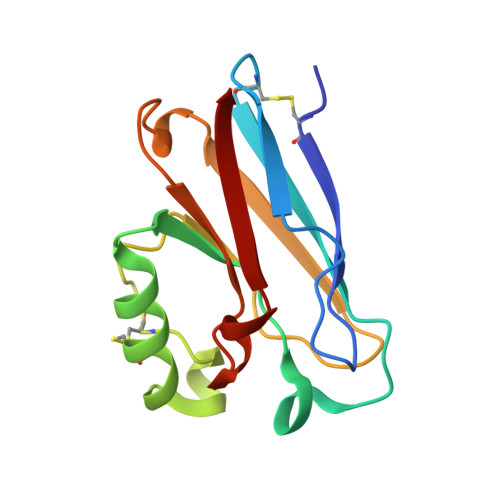Effects of a novel disulfide bond and engineered electrostatic interactions on the thermostability of azurin
Tigerstrom, A., Schwarz, F., Karlsson, G., Okvist, M., Alvarez-Rua, C., Maeder, D., Robb, F.T., Sjolin, L.(2004) Biochemistry 43: 12563-12574
- PubMed: 15449946
- DOI: https://doi.org/10.1021/bi048926x
- Primary Citation of Related Structures:
1XB3, 1XB6, 1XB8 - PubMed Abstract:
Identification and evaluation of factors important for thermostability in proteins is a growing research field with many industrial applications. This study investigates the effects of introducing a novel disulfide bond and engineered electrostatic interactions with respect to the thermostability of holo azurin from Pseudomonas aeruginosa. Four mutants were selected on the basis of rational design and novel temperature-dependent atomic displacement factors from crystal data collected at elevated temperatures. The atomic displacement parameters describe the molecular movement at higher temperatures. The thermostability was evaluated by optical spectroscopy as well as by differential scanning calorimetry. Although azurin has a high inherent stability, the introduction of a novel disulfide bond connecting a flexible loop with small alpha-helix (D62C/K74C copper-containing mutant), increased the T(m) by 3.7 degrees C compared with the holo protein. Furthermore, three mutants were designed to introduce electrostatic interactions, K24R, D23E/K128R, and D23E/K128R/K24R. Mutant K24R stabilizes loops between two separate beta-strands and D23E/K128R was selected to stabilize the C-terminus of azurin. Furthermore, D23E/K128R/K24R was selected to reflect the combination of the electrostatic interactions in D23E/K128R and K24R. The mutants involving electrostatic interactions had a minor effect on the thermostability. The crystal structures of the copper-containing mutants D62C/K74C and K24R have been determined to 1.5 and 1.8 A resolution. In addition the crystal structure of the zinc-loaded mutant D62C/K74C has also been completed to 1.8 A resolution. These structures support the selected design and provide valuable information for evaluating effects of the modifications on the thermostability of holo azurin.
- Department of Chemistry, Lundberg Institute, Göteborg University, Box 462, SE-405 30 Göteborg, Sweden.
Organizational Affiliation:

















